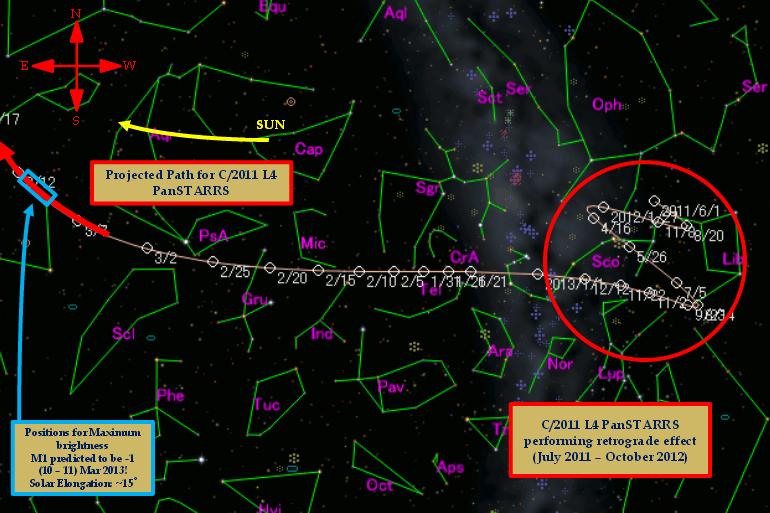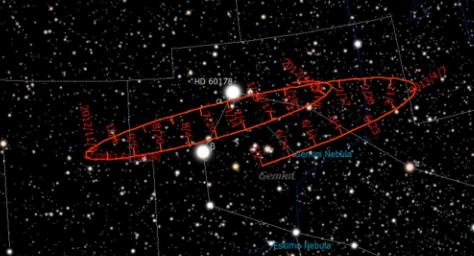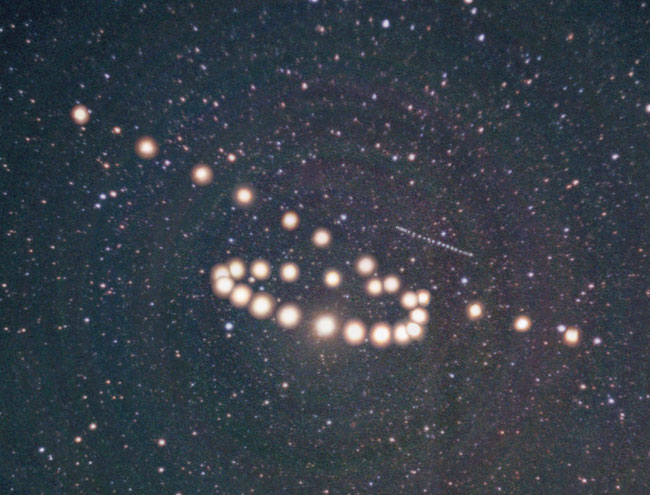It looks like you're using an Ad Blocker.
Please white-list or disable AboveTopSecret.com in your ad-blocking tool.
Thank you.
Some features of ATS will be disabled while you continue to use an ad-blocker.
share:
Maybe this will explain a little better. There are many pictures to post but I posted like 2 from that pdf paper file.


www.astronomyhouston.org...


www.astronomyhouston.org...
Originally posted by NeoParadigm
reply to post by filledcup
Hubble changed position making it look like the comet took another path.
This has been posted on almost every page of this thread.edit on 20-8-2013 by NeoParadigm because: (no reason given)
ok im going to ask a stupid question. is the hubble 'tracking' the comet as it films? or is hubble just focusing on the general area in which the comet is, sort of hoping to catch it in the frame?
as the hubble moves in orbit.. i am guessing the hubble moves in a horizontal orbit in relation to the sun and our solar system. is it moving from left to right or right to left right(east-west) (like the way the moon orbits earth)? or can hubble move north-south as well in the galactic plane?
i guess what im asking is to justify the reasoning for the zigzag pattern we see. what change of viewpoint causes this? when i look at the sun at midday and it is directly overhead.. as i move the sun still appears to be directly over head. if i change my viewpoint filming the path of the sun in the sky, the path should not appear to change direction since the sun is heading a steady course.
edit on 20-8-2013 by filledcup because: (no
reason given)
Regardless of all the explanations given, I smell
something fishy here
something fishy here
Originally posted by Angelic Resurrection
Regardless of all the explanations given, I smell
something fishy here
You should consider checking the trash bins around you, the dishwasher, and the disposal in the sink.
If you still have a fishy smell, consider calling a professional.
reply to post by filledcup
Did you read my post? I posted a picture of apparent retrograde motion of mars and THAT'S WITH OUR VISIBLE EYES!

Did you read my post? I posted a picture of apparent retrograde motion of mars and THAT'S WITH OUR VISIBLE EYES!

Originally posted by Deaf Alien
reply to post by filledcup
Did you read my post? I posted a picture of apparent retrograde motion of mars and THAT'S WITH OUR VISIBLE EYES!
yes i did. but i think it's a little different for an observer 'from space' as compared to an observer on the ground. ppl get confused by the gyroscopic nature of the planetary and solar system rotation.
for instance.. i am standing on earth and looking up at the sun.. but truth is i am looking sideways at the sun. this changes things. from space the perception is different.
can we display this motion of the comet from an overhead view? i guess im just struggling with wrapping my mind around the point of view which would cause this zigzag appearance from space. what change in viewpoint would cause that?
edit on 20-8-2013 by filledcup because: (no reason
given)
reply to post by filledcup
upload.wikimedia.org...
and,
upload.wikimedia.org...
and,
These exposures were made while the telescope tracked the stars. Because of the motion of the comet and the motion of HST in its orbit around the Earth, the comet trailed slightly relative to the stars during and between these exposures. This is not the way comets are usually observed. Normally we would track on the comet to keep it stationary in the camera during the exposure. However, in this case we wanted to produce an image of the comet against a background clearly showing stars and galaxies.
edit on 20-8-2013 by NeoParadigm because: (no reason given)
edit
on 20-8-2013 by NeoParadigm because: (no reason given)
reply to post by filledcup
As it goes in the opposite direction on the other side of the Earth.
what change in viewpoint would cause that?
As it goes in the opposite direction on the other side of the Earth.
reply to post by NeoParadigm
Yes imagine the telescope orbiting the Earth PLUS the Earth orbiting the Sun (as I had given an example on apparent retrograde motion of Mars)
Yes imagine the telescope orbiting the Earth PLUS the Earth orbiting the Sun (as I had given an example on apparent retrograde motion of Mars)
Originally posted by PlanetXisHERE
Of course I welcome debate and counter arguments, but if they involve taking NASA at their word - then the debate is certainly not settled.
But that was the whole point of my post.
You DONT have to take NASA's word for it.
The comet is up there in the freaking sky for anyone to see!
Time and time again on ATS, people say that they'd love to have some kind of concrete evidence/proof of aliens, government coverups and conspiracies.
And yet, when a thread comes along saying that a comet is behaving in a mysterious way... not a single one of you, nobody, not a single soul among you, has done any more than ponder an old photograph taken 6 moths ago.
Not a single one of you has said "yes, NOW we have the proof", and went to seek out a bit of telescope viewing time.
I imagine it would be the same if aliens landed on the White House lawns. Rather than go and look for yourselves, you'll all be arguing over a screencap from an old History channel documentary.
For those of you who are indeed convinced its not a normal comet, why havnt you bothered to contact a local astronomy group so you get get evidence first hand?
Originally posted by Trillium
Ok I will say it again
The effect of stacking the 3 images could be right but I don't buy into the the green line and the red time base because it generated by a program from a earth base view point they should not match. so something is still not right.
No, the line showing ISON's position is plotted from Hubble, not from the Earth. The 3 streaks of light are from the 3 440 second exposures taken with the F606W filter. You can see the data entries here: archive.stsci.edu...
Based on the first two entries in that table, along with the previous blog post describing the image, we can see that between 03:35:43 and 04:24:07 on April 30th, Hubble made a 440 second exposure with the F606W filter, then a 490 second exposure with the F814W filter, then another 440 second exposure with the F606W filter, another 490 second exposure with the F814W filter, and a final 440 second exposure with the F606W filter. The 3 exposures with the F606W filter were all done on the same image. So that's why you get 3 streaks of the light.
reply to post by alfa1
alfa is correct. You can go out there and take a look for yourself. Get a good telescope or you can rent a telescope online.
Go see for yourself.
NASA may be a nasty organization full of liars wanting to be all secretive.... But this one? YOU can go see for yourself.
alfa is correct. You can go out there and take a look for yourself. Get a good telescope or you can rent a telescope online.
Go see for yourself.
NASA may be a nasty organization full of liars wanting to be all secretive.... But this one? YOU can go see for yourself.
reply to post by alfa1
Tbh, what you say is not completely valid,
From what I heard it wouldn't be visible to amateur astronomers in DETAIL till late summer, which is in the coming weeks.
I haven't seen you post any links to amateur astonomers that have been watching it, and if anyone here had acces to a good telescope they would've probably used it by now.
Tbh, what you say is not completely valid,
From what I heard it wouldn't be visible to amateur astronomers in DETAIL till late summer, which is in the coming weeks.
I haven't seen you post any links to amateur astonomers that have been watching it, and if anyone here had acces to a good telescope they would've probably used it by now.
Originally posted by NeoParadigm
I haven't seen you post any links to amateur astonomers that have been watching it...
I posted a link back on page 20.
Originally posted by NeoParadigm
... and if anyone here had acces to a good telescope they would've probably used it by now.
Thats exactly the point.
They **HAVE** been watching it in the last few weeks.
Edit - this link to a photo taken on the 20th.
Its just one example of many amateur astronomers who are viewing this thing, every night.
edit on 20-8-2013 by alfa1 because: (no reason given)
Originally posted by NeoParadigm
reply to post by filledcup
upload.wikimedia.org...
and,
These exposures were made while the telescope tracked the stars. Because of the motion of the comet and the motion of HST in its orbit around the Earth, the comet trailed slightly relative to the stars during and between these exposures. This is not the way comets are usually observed. Normally we would track on the comet to keep it stationary in the camera during the exposure. However, in this case we wanted to produce an image of the comet against a background clearly showing stars and galaxies.edit on 20-8-2013 by NeoParadigm because: (no reason given)edit on 20-8-2013 by NeoParadigm because: (no reason given)
ok so hubble is orbiting the earth basically along a band of the equator while it films the backdrop? let me just say.. my imagination says that would not cause any apparent change of direction. but earth's movement around the Sun would. just.. how much would the earth move around the sun in 43 minutes? i dont think it would enough to show such a change. had this been a composite of images over a period of months yes.
next.. also.. even if Nasa is stacking images.. i think they would do better to stack the images in proper calculation to their change in viewpoint showing a steady path instead of this crooked 'laziness' as i will call it now. and i dont mean the multiple zigzag pattern. just the one 'winged disc' image. why didnt they stack the images in line.
now i have to calculate hubble's time to orbit earth, it's position at the first capture and last capture, the time it took to get there over the distance of orbit covered. yaay!
edit on 20-8-2013 by filledcup because: (no reason given)

quoted from chandra.harvard.edu...
"G1.9+0.3 is the remains of the most recent supernova, in Earth's time frame, known to have occurred in the Milky Way."
"If gas and dust had not heavily obscured it, the explosion would have been visible from Earth just over a century ago."
from,,
www.txstate.edu...
Researchers say star in Hamlet may be supernova of 1572,,,
That Supernova in 1572 was Nuburu go boom.or as this guy said:
Tycho Brahe
Nobleman
Tycho Brahe, born Tyge Ottesen Brahe, was a Danish nobleman known for his accurate and comprehensive astronomical and planetary observations. He was born in Scania, then part of Denmark, now part of modern-day Sweden. Wikipedia.
She was one big boom!
Now that may explain these new Comets,,,,just riding the wave ,,man. lol

edit on 20-8-2013 by BobAthome because: (no reason given)
reply to post by alfa1
Missed that link.
My point is that they can see it right now, but not in detail, so if it were a spaceship or something, amateurs wouldn't be able to tell at this point, but they can see that it's there off course.
At least that's what I read.
Missed that link.
My point is that they can see it right now, but not in detail, so if it were a spaceship or something, amateurs wouldn't be able to tell at this point, but they can see that it's there off course.
At least that's what I read.
new topics
-
Sorry to disappoint you but...
US Political Madness: 30 minutes ago -
Watch as a 12 million years old Crab Emerges from a Rock
Ancient & Lost Civilizations: 5 hours ago -
ILLUMINATION: Dimensions / Degrees – Da Vincis Last Supper And The Philosophers Stone
Secret Societies: 11 hours ago
top topics
-
Speaking of Pandemics
General Conspiracies: 14 hours ago, 9 flags -
ILLUMINATION: Dimensions / Degrees – Da Vincis Last Supper And The Philosophers Stone
Secret Societies: 11 hours ago, 9 flags -
Watch as a 12 million years old Crab Emerges from a Rock
Ancient & Lost Civilizations: 5 hours ago, 9 flags -
Just Sick of It! Done! Can't take it anymore!
General Chit Chat: 12 hours ago, 8 flags -
Stuck Farmer And His Queue Jumping Spawn
Rant: 14 hours ago, 4 flags -
Sorry to disappoint you but...
US Political Madness: 30 minutes ago, 3 flags
active topics
-
Sorry to disappoint you but...
US Political Madness • 1 • : CriticalStinker -
Joe Biden gives the USA's Highest Civilian Honor Award to Hillary Clinton and George Soros.
US Political Madness • 41 • : Flyingclaydisk -
Just Sick of It! Done! Can't take it anymore!
General Chit Chat • 14 • : Flyingclaydisk -
What Is 'Quad Demic'? Mask Mandate Returns In These US States
Diseases and Pandemics • 38 • : NorthOS -
Musk calls on King Charles III to dissolve Parliament over Oldham sex grooming gangs
Mainstream News • 176 • : cherokeetroy -
Winter Storm
Fragile Earth • 32 • : Irishhaf -
Vehicle Strikes people in New Orleans
Mainstream News • 300 • : Oldcarpy2 -
DONALD J. TRUMP - TIME's Most Extraordinary Person of the Year 2024.
Mainstream News • 61 • : Oldcarpy2 -
Candidate Harris Supporter MARK CUBAN Says Trump Has No Smart-Intelligent Women in His Orbit.
2024 Elections • 88 • : Oldcarpy2 -
Matthew Livelsberger said he was being followed by FBI
Political Conspiracies • 72 • : WeMustCare
